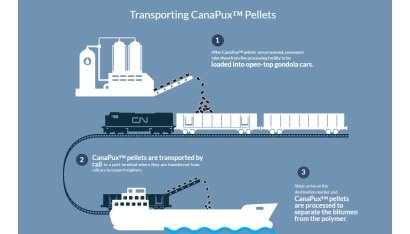
Bitumen, a vital component of road construction, is transported efficiently through a network of pipelines and tankers. Pipelines offer a cost-effective and secure means of transportation, while tankers ensure flexibility in delivering bitumen to various locations. The process of how is bitumen transported is a crucial aspect of the infrastructure industry, impacting the timely completion of road projects. Let’s delve into the intricate journey of bitumen as it travels from refineries to construction sites, fueling the progress of our roads.
How is Bitumen Transported: A Comprehensive Guide
Welcome to our detailed guide on how bitumen, a crucial material used in various industries, is transported from one place to another. Bitumen, also known as asphalt or tar, is a viscous, black, and sticky substance derived from crude oil. Its versatility makes it an essential component in road construction, waterproofing, and other applications. Let’s delve into the fascinating world of bitumen transportation!
Understanding Bitumen
Before we explore how bitumen is transported, let’s understand what it is and why it’s so important. Bitumen is a byproduct of the petroleum refining process and is commonly used in road construction due to its excellent binding properties. It acts as a glue that holds together the various aggregates in asphalt concrete.
Transportation Methods
There are several methods used to transport bitumen from refineries to various destinations. The most common methods include:
1. Tanker Trucks
Tanker trucks are a popular choice for short to medium-distance transportation of bitumen. These trucks are specially designed to transport bitumen safely and efficiently. The bitumen is loaded into insulated tanks on the trucks and delivered to construction sites, emulsion plants, or storage facilities.
2. Rail Transport
Rail transport is another widely used method for moving large volumes of bitumen over long distances. Specialized railcars are used to transport bitumen in bulk. This method offers cost-effective and reliable transportation, especially for remote locations where road access may be limited.
3. Bitumen Tankers
For transporting bitumen overseas or across water bodies, bitumen tankers are utilized. These tankers are specifically designed to handle the unique properties of bitumen and ensure safe delivery to various ports around the world. Bitumen tankers play a crucial role in the global distribution of this valuable material.
Challenges and Solutions
Transporting bitumen comes with its own set of challenges, primarily due to its high viscosity and temperature sensitivity. To overcome these challenges, industry experts have developed innovative solutions:
1. Heating Systems
One of the main challenges in transporting bitumen is maintaining its temperature to prevent solidification. Heating systems are integrated into transportation vehicles and containers to keep the bitumen at the optimal temperature throughout the journey. This ensures that the bitumen remains in its liquid state and can be easily unloaded upon arrival.
2. Insulation
Insulation plays a crucial role in preventing heat loss during transportation. Tanker trucks, railcars, and tankers are equipped with high-quality insulation materials to retain the heat generated by the heating systems. This helps in preserving the viscosity of bitumen and ensures smooth unloading operations.
Environmental Considerations
Bitumen transportation, like any other industrial activity, has environmental implications. Spills or leaks during transportation can have adverse effects on the environment. To mitigate these risks, companies adhere to strict safety protocols and regulations:
1. Spill Prevention Measures
Transportation vehicles are equipped with spill prevention and containment systems to minimize the risk of leaks or spills. Regular maintenance checks and inspections are carried out to ensure the integrity of the transportation equipment and prevent environmental incidents.
2. Emergency Response Plans
In the rare event of a spill or leak, companies have well-defined emergency response plans in place. Trained personnel, specialized equipment, and containment measures are deployed swiftly to mitigate the impact on the environment and human health. Safety is paramount in the transportation of bitumen.
In conclusion, the transportation of bitumen is a complex yet essential process that involves specialized equipment, innovative solutions, and a focus on safety and environmental protection. By understanding how bitumen is transported and the challenges involved, we can appreciate the intricate supply chain that brings this valuable material to various industries around the world. Next time you see a freshly paved road or a waterproof roof, remember the journey of bitumen that made it possible!
Thank you for joining us on this exploration of how bitumen is transported. Stay tuned for more informative content on industrial processes and materials. Happy reading!
How exactly is bitumen transported?
Frequently Asked Questions
How is bitumen typically transported?
Bitumen is commonly transported via two main methods: by truck or by rail. Trucks are used to transport bitumen in heated liquid form in specially designed tankers, while rail transport involves moving bitumen in insulated tank cars.
What safety measures are in place during the transportation of bitumen?
When transporting bitumen, safety measures are paramount to prevent accidents and spills. This includes using specialized transportation vehicles with secure tank compartments, conducting regular inspections to ensure proper equipment functioning, and following strict protocols for loading, unloading, and handling the bitumen.
Are there any environmental considerations when transporting bitumen?
Transporting bitumen can have environmental implications if proper precautions are not taken. To minimize the impact, spill containment procedures and emergency response plans are implemented. Additionally, efforts are made to ensure that vehicles are well-maintained to prevent leaks and spills during transportation.
Final Thoughts
In conclusion, bitumen is primarily transported through pipelines, ships, rail tank cars, and trucks. Pipelines are the most common and efficient method due to their capacity and cost-effectiveness. Ships are used for long-distance transportation to reach global markets. Rail tank cars and trucks are utilized for shorter distances and more flexible delivery options. Overall, the transportation of bitumen plays a crucial role in supplying this valuable resource to various industries around the world.






